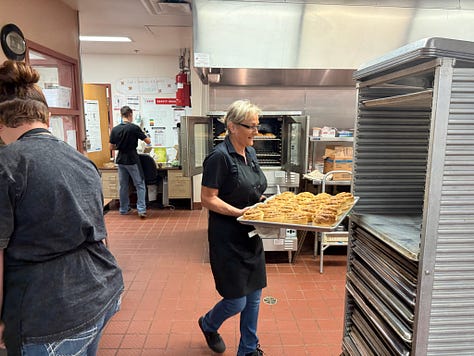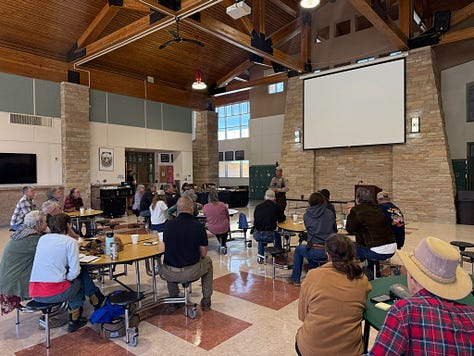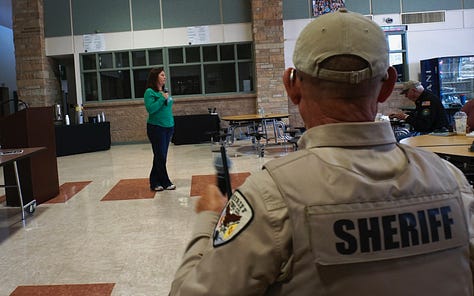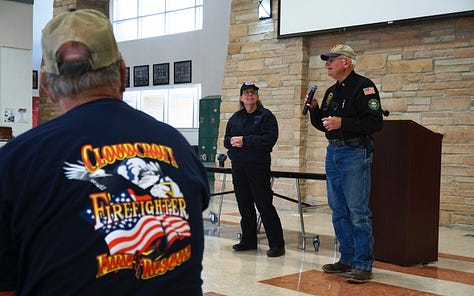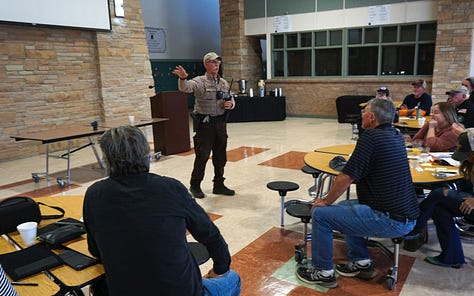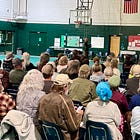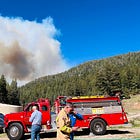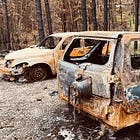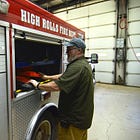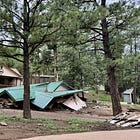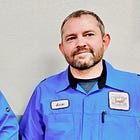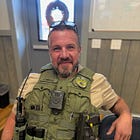Public Safety: Leadership Cloudcroft Emergency Management Notes
Leadership Cloudcroft, community leaders, and regional emergency managers recently met to discuss Emergency Management on the mountain
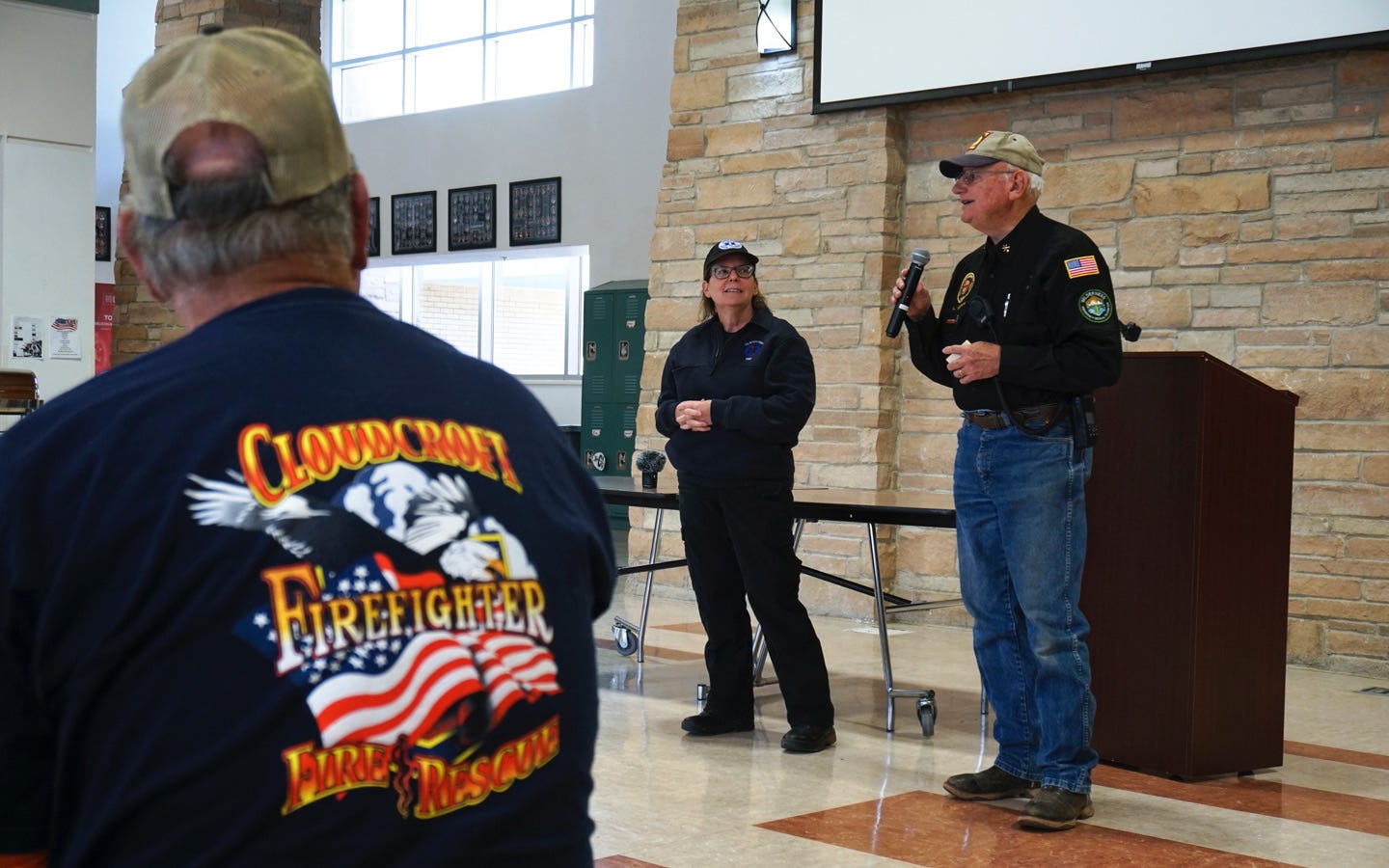
On Saturday, September 20th, the Leadership Cloudcroft cohort and key community members gathered at the High School Commons to discuss emergency management in and around the village.
The Leadership Cloudcroft group was joined by community figures including mayoral candidate Dusty Wiley, Burro Street Exchange owner Phyllis Turner, new Chamber of Commerce Manager Maddie Garner, Sacramento Camp Program Manager Rachel Tvede, and others.
Attendees enjoyed a lunch of enchiladas and all the fixings, prepared by students from the school’s Culinary Program. As they dined, they listened to presentations from local emergency managers and asked questions about public safety.
Who are our local first responders?
Otero County Office Emergency Services, headed by Matt Clark, is the central hub for emergency incidents on the mountain. Calls for 911 are routed through the Tularosa Basin Regional Dispatch Authority, which serves Cloudcroft even after TBRDA’s recent restructuring.
National Forest Hotshot team members and crews are stationed in the Lincoln National Forest. During peak fire season, a rotating cast of hotshot crews can be seen in and around Cloudcroft.
We’re also served by our local volunteer fire department and EMTs, the Otero County Sheriff’s Office, the Lincoln National Forest law enforcement officers (of which there are now two), Game & Fish, and the State Police.
According to the Cloudcroft VFD, the recent consolidation of the Otero County Volunteer Fire Departments will not affect our local station.
Cloudcroft’s Police Department now consists of a sole officer-in-training, Ali Manzo. At the regular September council meeting, Mayor Tim King said the village has candidates who’ve applied for Cloudcroft PD positions.
Who patrols Cloudcroft now?
Roger Schoolcraft spoke about the Otero County Sheriff’s coverage of the mountain—he arrived at the session a few minutes late after responding to incidents in Timberon and Mayhill.
After stepping down as Cloudcroft’s Chief of Police in December 2024, he now serves as a Mountain Deputy with the Otero County Sheriff’s Office. Four deputies are covering 220 square miles, including Cloudcroft.
Schoolcraft is joined by officers Mitchell, Lauder, and Jones.
Schoolcraft stated that the mutual aid partnerships are strong between multiple agencies, including Game & Fish officers, the State Police, and Forest Service law enforcement officers. Cross-commissioned officers can respond within Cloudcroft’s village limits.
Their typical response time can be up to 45 minutes, depending on their location and road conditions.
“My resources at any given time may be really narrow… so we call the state police. We need mutual aid. In Alamogordo, I make a traffic stop and somebody’s giving me a hard time… within two minutes, I’ve got two officers right there helping me out. Up here, it might be five or ten minutes or 15 minutes, depends on what’s going on,” he said.
One challenge is the radio communication dead zones two miles east of Cloudcroft on Highway 82.
On Cloudcroft’s PD
“I think a police department should be fundamental to every community in the United States, whether it’s a four-man police department or a two-man police department,” he said.
Schoolcraft emphasized that the police chief in Cloudcroft should be a “working chief of police,” meaning someone who is not just an administrator but is actively out in the community, taking calls and leading by example. He states: “You don’t sit in an office in a small community, with your chief badge on, and not be out taking calls. You’d better be Johnny-on-the-spot, the guy that they can call.”
He said that in the process of hiring a new chief, it is crucial to choose someone who is invested in the community, understands community policing, and intends to stay long-term, not just treat the job as a brief assignment.
“The worst thing you can have is an invisible police force. If you’re not out patrolling the community, being an active presence… then what good are they to the village?”—Deputy Roger Schoolcraft
Schoolcraft stressed that the chief’s responsibility is to look out for their people—meaning the officers and the community alike—and that “it’s just find the right people, keep them in place, keep them happy, train good equipment, and have a good chief of police that’s going to take care of their people and be a working chief of police”.
Safety and our schools
Elementary and Middle School Principal—and Cloudcroft alumna— Nolene Adams serves as Cloudcroft Schools’ Emergency Coordinator.
The school recently upgraded its infrastructure with a new radio system, and will use the GO Bond to fund additional security vestibules at school entrances.
“One of the biggest things about safety is it costs a lot of money. Especially in the school system. Our bond is coming up, and so I really do want to encourage you to vote,” Adams said.
Older grades use lockers, and backpacks aren’t allowed in the classroom.
“All of their stuff is in their lockers, and we do random bag checks. As a middle school teacher, kids were vaping in my classroom. And I could not catch them,” Adams said.
When asked how the Yondr pouches and cell-phone lockdowns could affect a crisis, Adams said that the absence of an influx of calls would prevent cell tower overloads and allow the emergency managers to coordinate with responders.
The school regularly practices emergency protocols and training:
Monthly drills for fire, evacuation, active shooters, and barricading
Staff receive full-day emergency management training annually
Crisis Prevention Intervention (CPI) training for de-escalation
“We’re attempting to do that with the least distraction to the students… the number one priority is that we’re taking care of our kids and their mental health,” said Adams of the schools’ regularly-scheduled drills.
“We met with the entire county safety network, including the forest service, the sheriff’s office, State police, the local emergency dispatch agencies, just so that they know our protocols and procedures when something does happen,” Adams said.
Multiple agencies, like the VFD and the Sheriff’s office, have keys to the school so they can respond to incidents quickly.
Schoolcraft weighed in on the Sheriff’s response to a school emergency, like an active shooter: “My responsibility as a law enforcement officer is to address the threat. That’s it. It’s not to tend to injured children on the ground or teachers. It’s to go to the threat, and we have to neutralize the threat.”
“The school has set up evacuation routes that everyone’s aware of through the schools and the parents—of where the kids will be taken in case we have a mass emergency where the children need to be evacuated from the school,” he continued.
The school sends out the reunification process paperwork to parents each year.
Volunteer Fire Department stats
About 30 active members volunteer at Cloudcroft’s VFD, most of whom are 50+ years old, according to District Chief Lewis Hornbuckle.
Junior membership is offered starting at age 14, which enabled Cloudcroft’s VFD Chief Erich Wuersching to serve for over 30 years.
The VFD takes on many roles in emergency management. It’s not all “running into a house fire”, according to EMT Hilary Kitzman. They need folks for firefighting, of course, but also pump operation, traffic control, EMT services, and more.
The VFD offers regular training at the fire station across from Ski Cloudcroft and hosts monthly dinner meetings. The annual fire academy occurs in late March and early April, and all members are required to complete the Wildland Firefighter certification.
Citizens are encouraged to join the VFD’s newest offering, the Community Emergency Response Team (CERT) program, where they’ll receive:
FEMA-approved training for non-firefighter volunteers
Basic instruction in fire suppression, search & rescue, and evacuation assistance
The program has a lower commitment level than firefighting roles and aims to prepare citizens to step up during emergencies.
This article continues after a brief message. Thank you to our Leadership Cloudcroft sponsors and partners:
Infrastructure concerns
Large structure fires can quickly exhaust the municipal water supply, making water supply sustainability during major fires a critical need.
Chief Wuersching stated that communication infrastructure challenges include bottlenecks created by multiple robodial systems funneling through dispatch.
The village has multiple sirens, and hardwired emergency alert infrastructure was listed as priority number two on the village’s Infrastructure Capital Improvement Plan. The project is designed and awaits legislative funding.
Wuershing said folks can sign up for and check for updates through these emergency alert systems:
IPAWS (federal geofenced alerts for tourists/travelers through FEMA)
Radio 97.9 FM emergency broadcasts
Local sirens—Cloudcroft’s are WW2-era and function as sirens-only. The village has planned upgrades to enhance voice capabilities, enabling the delivery of specific instructions.
Social media (Cloudcroft Fire Department, TBRDA, Village of Cloudcroft, etc.)
Cloudcroft’s emergency management funding is currently allocated to the Fire Department through the Fire Protection Fund. While Chief Wuersching serves as the village’s Emergency Manager, he says VFD staff are cross-trained in emergency management and know what to do.
According to Wuersching, the primary evacuation route is Highway 82, likely heading east toward Artesia. A secondary evacuation route is Highway 244, depending on the wind. In extreme situations, Highway 130 can be used.
The village has agreements with surrounding counties for evacuation shelters and support.
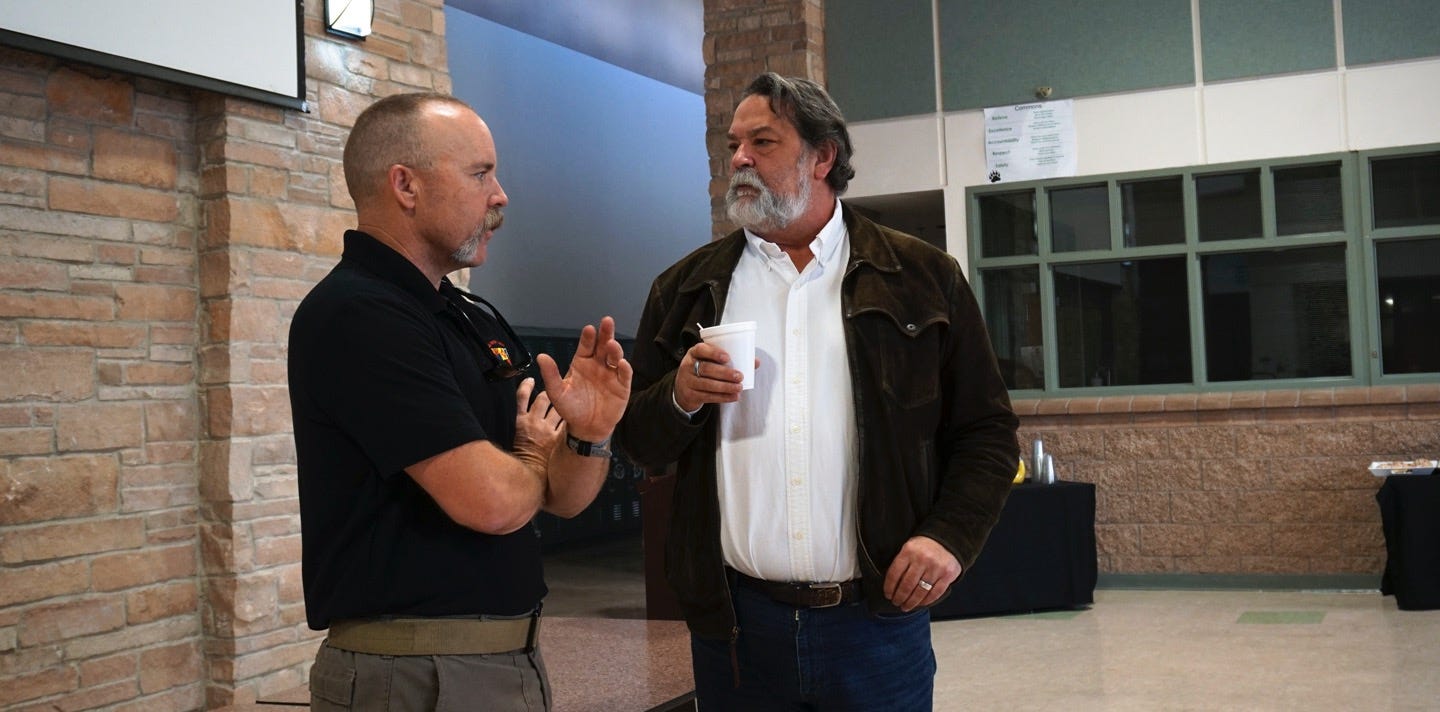
When does an incident require a management team?
A Federal incident management team is called in for a complex emergency and manages response based on a range of variables: affected communities, municipalities, weather, terrain, hazmat issues, and more.
IMTs respond to a range of emergencies, anywhere from fire to bird flu, during the incident. Post-disaster recovery typically falls to FEMA for federally-based efforts.
More Incident Management Team facts:
IMTs can be staffed with 75-100 personnel
They deploy nationwide within 24-36 hours for complex fires
Team members serve 12-month rotations with specialized roles
IMTs handle Type 1-3 complexity incidents beyond local capacity
Multiple IMT teams across the Southwest can protect Cloudcroft
Teams respond to incidents requiring evacuation coordination and work with the local Office of Emergency Services for evacuation recommendations and notices.
According to National Incident Team Commander and Lincoln National Forest Zone Fire Management Officer Caleb Finch, Cloudcroft is New Mexico’s number one at-risk community for fire.
Fire mitigation projects
Finch explains that large-scale thinning projects were conducted around Cloudcroft’s perimeter from 1999 to 2005, but now fresh forest growth means that “we need to go back into these treatments that were treated in the early 2000s on about a 20 to 25 year cycle.”
He reports that a new thinning and fuel treatment project, covering about 3,000 acres around the village, should be ready to begin as soon as next September—with most requirements and surveys already completed, and roughly $2 million in funding allocated.
Finch details that the work will involve “mechanical thinning of the reproduction that’s come in in the last 20 to 25 years” as well as use of prescribed fire,.
“Prescribed fire is the best tool to limit and reduce the impact of… any kind of other risk out there… Mechanical is the right tool as well, but you’ve got to look at the landscape and find out where fire fits best,” he says. “I like to tell everybody we live in the forest and there were fires here long before humans were here and there will be fire in the forest long after humans are gone.”
When asked about the worst-case-scenario fire in Cloudcroft, Finch said, “Any fire in a forest in those conditions is going to move pretty quickly… There have been fires here in Lincoln that have burned 35,000 acres in two days.”
Mayor King said that the recent Federal Fix Our Forests Act would allow for extended utility company right-of-ways to cut trees further from power lines.
Partnerships and resources
All of the Leadership Cloudcroft session speakers emphasized the need for solid partnerships and communication.
Finch emphasized that private landowners’ efforts are essential: “The community and local landowners have to do their part as well, because if you look at a majority of fires, the majority of fires start on private property and run out to the forest.”
Here are a few of the programs and initiatives they mentioned where citizens can make an impact:
FireWise: Cloudcroft recently gained FireWise community status, which involves community cleanup.
Finch emphasised that private property responsibility is crucial. “Just that little bit of work can make a huge difference in savings—a home, big difference. It has to happen annually every year. It’s the vegetation on the ground that reduces the ground fuel. This is the key to reducing the risk of a fire that might get close to some residences,” he says. Limb up your trees to reduce ladder fuels, rake up your pine litter, and mow your grass.
Schoolcraft encouraged business owners to put in security cameras to help solve crimes, and gave a shout-out to Mayor King for the recent installation of cameras around the village: “Surveillance cameras are such a huge asset for everyone. It just tells us, gives us a bird’s eye picture of what’s going on or what happened and weather conditions.”
Kitzman and Hornbuckle encouraged folks to join the CERT program. For more info, click here.
We look forward to publishing additional resources, such as Reader Reels and YouTube videos, of the Leadership Cloudcroft: Emergency Management sessions soon.
